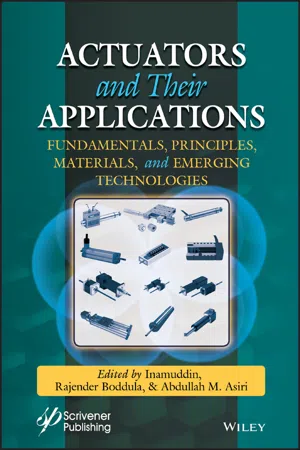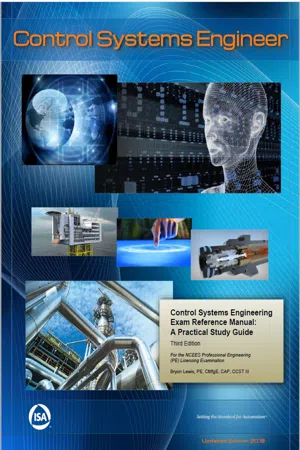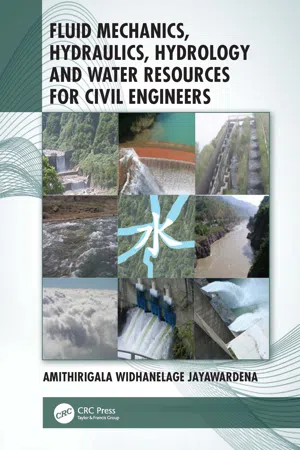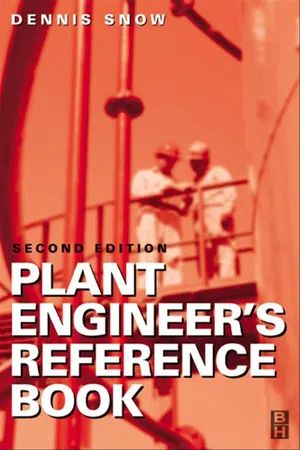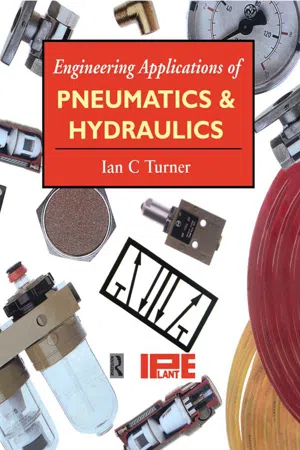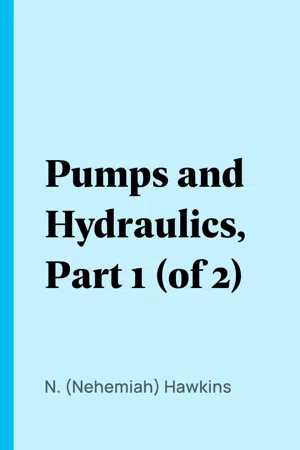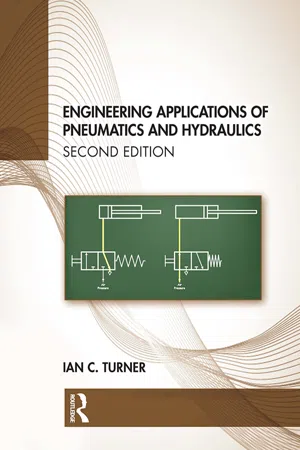Fluid Power Pumps and Motors
Fluid power pumps and motors are essential components in hydraulic systems, providing the means to convert mechanical energy into fluid power. Pumps are used to generate fluid flow and create hydraulic pressure, while motors convert hydraulic energy back into mechanical energy. These devices play a crucial role in various applications, including construction equipment, manufacturing machinery, and aerospace systems.
8 Key excerpts on "Fluid Power Pumps and Motors"
- eBook - ePub
Fluid Power Circuits and Controls
Fundamentals and Applications, Second Edition
- John S. Cundiff, Michael F. Kocher(Authors)
- 2019(Publication Date)
- CRC Press(Publisher)
...1 Brief Overview of Fluid Power 1.1 Introduction In 1906, oil began to replace water as the pressurized fluid in hydraulic systems, and the modern era of fluid power began. Electrical control of fluid power began to enter the commercial sector with the development of servo valves in World War II. Today, the fluid power industry is a multi-billion dollar industry. Most mobile machines in the extraction industries (mining, logging, farming, and fishing) have fluid power circuits, thus fluid power is a major factor in the collection of raw materials for the international economy. Fluid power is an important part of most vehicles in the transportation industry. In manufacturing, the application of fluid power has continuously increased the productivity of workers and thus has had direct impact on the standard of living. Today, fluid power is a part of every product we use and service we enjoy. 1.2 Concept of Fluid Power This text leads the reader through several levels of complexity beginning with simple circuits with a simple function and concluding with an introduction to the use of servo valves to control heavy loads moving at high speed. As we proceed along this journey, the reader will be periodically reminded that the fundamental concept of fluid power is quite simple. Fluid power technology is the conversion of mechanical energy to fluid energy, delivery of this energy to a utilization point, and then its conversion back to mechanical energy. A fluid power circuit has all three features: conversion from mechanical energy to fluid energy, delivery, and conversion from fluid energy back to mechanical energy. An electrical circuit also has all three features, but often the designer focuses only for the final conversion step—electrical-to-mechanical. Generation of the electrical energy and its delivery are external to the design problem. 1.2.1 Basic Circuits Many people have an intuitive understanding of a basic cylinder circuit and a basic motor circuit...
- eBook - ePub
Actuators and Their Applications
Fundamentals, Principles, Materials, and Emerging Technologies
- Rajender Boddula, Abdullah M. Asiri, Rajender Boddula, Abdullah M. Asiri(Authors)
- 2020(Publication Date)
- Wiley-Scrivener(Publisher)
...8 Fluid Power Actuators Mohanraj Thangamuthu 1, Tamilarasi Thangamuthu 2, Gobinath Velu Kaliyannan 3, Moganapriya Chinnasamy 3 and Rajasekar Rathinasamy 3 * 1 Department of Mechanical Engineering, Amrita School of Engineering, Amrita Vishwa Vidyapeetham, Coimbatore, India 2 Department of Mechatronics Engineering, Kongu Engineering College, Perundurai, Erode, India 3 Department of Mechanical Engineering, Kongu Engineering College, Perundurai, Erode, India Abstract Fluid power is the use of fluids (liquid/air) under high pressure to generate, control, and transmit power. Fluid power systems are used to transmit power from a central source to industrial users over extended geographic areas. Fluid power actuator consists of cylinder or motor that uses fluid power to assist mechanical operation. The mechanical motion gives an output in terms of linear, rotatory, or oscillatory motion. This chapter deals the different types of fluid power actuators and its application in the field of mechanical engineering. Keywords: Fluid power, hydraulics, pneumatics, actuators, cylinders, motors, valves 8.1 Introduction An actuator is an energy converter that converts energy from an external source into mechanical energy in a convenient way. The type of actuator depends on the input parameters used in the energy conversion process. For example, the input quantities of electromagnetic, piezoelectric and fluid power actuators can be the current, charge, and fluid pressure. Making use of the actuators, one can perform the required task. 8.2 Classification of Actuators Actuators are classified based on the material used as shown in Table 8.1 [ 1 ]. Fluid power actuators are one type of actuator which receives fluid either in the form of liquid or gas normally driven by an electric motor. This actuator transforms its energy into a linear or rotary motion to do a valuable task. Fluid power actuators are normally concerned with movement and application force on the object...
- Bryon Lewis(Author)
- 2019(Publication Date)
- International Society of Automation(Publisher)
...25 Hydraulics and Pneumatics Fluid Power Systems Fluid power is the use of fluids under pressure to generate, control, and transmit power. Fluid power is subdivided into hydraulics using a liquid such as mineral oil or water, and pneumatics using a gas such as air or other gases. Compressed-air and water-pressure systems were once used to transmit power from a central source to industrial users over extended geographic areas; fluid power systems today are usually within a single building or mobile machine. Hydraulic Systems The basic idea behind any hydraulic system is very simple: Force that is applied at one point is transmitted to another point using an incompressible fluid. The fluid is almost always an oil of some sort. The force is almost always multiplied in the process. The picture below shows the simplest possible hydraulic system: A simple hydraulic system consisting of two pistons and an oil-filled pipe connecting them. If you apply a downward force to one piston (the left one in this drawing), then the force is transmitted to the second piston through the oil in the pipe. Because oil is incompressible—the efficiency is very good—almost all the applied force appears at the second piston. The great thing about hydraulic systems is that the pipe connecting the two cylinders can be any length and shape, which enables installers to snake it through all sorts of things separating the two pistons. The pipe can also fork, so that one master cylinder can drive more than one slave cylinder if desired. In a hydraulic system, all you do is change the size of one piston and cylinder relative to the other to make a hydraulic amplifier, as shown in the next image. This is called hydraulic multiplication. The piston on the right has a surface area nine times greater than the piston on the left...
- Amithirigala Widhanelage Jayawardena(Author)
- 2021(Publication Date)
- CRC Press(Publisher)
...Chapter 12 Fluid machinery 12.1 Introduction Fluid machinery can be broadly classified into two types; namely, pumps and turbines. Pumps convert mechanical energy into fluid energy, thereby increasing the energy of the fluid (increase of pressure). Turbines convert the fluid energy into mechanical energy, thereby decreasing the energy of the fluid. Compressor is also a pump. Its primary function is to increase the pressure of the gas. Fan and Blower are machines used only for causing the movement of gas. 12.2 Types of pumps There are various types of pumps; some have only historical importance. Examples include. 12.2.1 Chain or bucket pumps This is the simplest type of pump that uses gravity lift. It has a valve which opens when it goes below the water line and closes when lifted above the water line. 12.2.2 Static or positive displacement pumps Positive displacement type functions by changes of the volume occupied by the fluid within the machine. They create an expanding cavity on the suction side and a contracting cavity on the delivery side. The operation of a positive displacement type machine depends only on mechanical and hydrostatic principles. Only a few principles of fluid dynamics are involved. Positive displacement pumps are more suitable for low flow high-pressure situations, and their efficiency is relatively independent of the pressure. They are preferred for moving viscous fluids such as oil, asphalt, etc. There are several types of positive displacement pumps. 12.2.2.1 Reciprocating type They are usually of piston−cylinder combination with inlet and exit valves involving suction and compression. Work done by pump is ∫ pdv, integrated over a complete cycle. If only one cylinder is working, the output will be fluctuating. If there are several cylinders, a fairly steady outflow can be maintained. They can also be single acting or double acting. In a single acting pump, the fluid is displaced in either the forward or backward stroke...
- eBook - ePub
- DENNIS A SNOW(Author)
- 2001(Publication Date)
- Butterworth-Heinemann(Publisher)
...20 Pumps and pumping Keith Turton, BSc(Eng), CEng, MIMechE, Visiting Fellow, School of Mechanical Engineering Cranfield University Contents Pump functions and duties Pump principles Rotodynamic pumps Scaling laws and specific speed Positive displacement pump principles Effects of fluid properties on pump behaviour Flow losses in systems Friction losses Losses in bends, valves and other features Presentation of system loss Interaction of pump and system Steady-state matching of pump and system Flow control Multiple-pump layouts Suction systems Cavitation Net positive suction head (NPSH) Priming systems Seals: selection and care Centrifugal pump and rotary pump seal systems Reciprocating pump seal systems Pump and drive selection Pump selection Drive selection The economics of pump selection and running maintenance Reliability considerations Pump testing Factory tests Scale-model testing 20.1 Pump functions and duties Pumps impart energy to the liquids being transferred by mechanical means using moving parts. They can be classified as rotodynamic or positive displacement. Rotodynamic pumps cause continuous flow, and the flow rate and discharge pressure are effectively constant with time. Positive displacement pumps deliver fixed quantities at a rate determined by driving speed. The main types of pump commonly used are listed in Figure 20.1. Figure 20.1 Pump family trees Pumps are used to transfer liquids, moving blood and other biological fluids, delivering measured quantities of chemicals as in dosing in water treatment, in firefighting, in irrigation, moving foods and beverages, pumping pharmaceutical and toilet products, in sewage systems, in solids transport, in water supply and in petrochemical and chemical plant. They are utilized in power transfer, braking systems, servomechanisms and control, as well as for site drainage, water-jet cutting, cleaning and descaling...
- Ian Turner(Author)
- 2014(Publication Date)
- Routledge(Publisher)
...An example of this can be found in robotics. In addition, safety conscious industries will sometimes adopt a number of technologies operating on different physical principles as a means of achieving diversity of operation, control and measurement on a given process. This is particularly significant as protection against common mode failure whereby if one system fails, the others remain active. 1.3 Uses of fluid power systems Fluid power systems may be used for: 1 Carrying out work by operating plant and machinery using linear, swivel and rotary motion. Some general methods of material handling used in industry, for example, may be: ■ clamping ■ shifting ■ positioning ■ orientating. a) General applications may be: ■ packaging ■ feeding ■ door or chute control ■ material transfer ■ turning and inverting of parts ■ sorting ■ stacking ■ stamping and embossing. b) Some general machining and work operations may be: ■ drilling ■ turning ■ milling ■ sawing ■ finishing and buffing ■ forming. Figure 1.1 A combined wellhead control panel and hydraulic power unit for an offshore oil platform 2 Controlling processes and plant. Pneumatic and hydraulic systems may be used to sense the operational status of a process, feed this information back to a controller which will take a necessary control action, for example a limit switch may sense that an actuator needs to be operated. 3 Measurements of process and/or machine parameters. Pneumatics and hydraulics can be used to provide measurements of process or machine parameters, act on this information and subsequently display it to an operator. The processes outlined in 1, 2 and 3 above may be used individually or in combination. Figure 1.2 Practical hydraulic emergency shut-down system for three sub-sea oil wells 1.4 Hydraulic and pneumatic safety systems In addition to operating, controlling and measuring parameters of process plant and machinery, hydraulics and pneumatics may be used in high integrity safety systems...
- eBook - ePub
- N. (Nehemiah) Hawkins(Author)
- 2018(Publication Date)
- Perlego(Publisher)
...WATER WHEELS. Hydraulic machinery may be broadly divided into 1. Motor machines, and, 2. Pumps. Water motors may be divided into 1. Water wheels, 2. Turbines, and, 3. Water pressure engines. In hydraulic motor machines a quantity of water descending from a higher to a lower level, or from a higher to a lower pressure, drives a machine which receives energy from the water and applies it to overcoming the resistances of other machines doing work. In the next general class, work done on the machine by a steam engine or other source of energy is employed in lifting water from a lower to a higher level. A few machines such as the ram and jet pump combine the functions of both motors and pumps. The subject of water wheels is but a continuation of much that has been illustrated and defined in the historical introduction to which is now added the following summary. In every system of machinery deriving energy from a natural water-fall there exist the following parts : (1) A supply channel, leading the water from the highest accessible level, to the site of the machine ; this may be an open channel of earth, masonry, or wood, or it may be a closed cast or wrought-iron pipe; in some cases part of the head race is an open channel, part a closed pipe. (2) Leading from the motor there is a tail race, culvert, or discharge pipe delivering the water after it has done its work. (3) A waste channel placed on or at the origin of the head race by which surplus water, in floods, escapes. (4) The motor itself, which either overcomes a useful resistance directly, as in the case of a ram acting on a lift or crane chain, or indirectly by actuating transmissive machinery, as when a turbine drives the shafting, belting, and gearing of a mill...
- Ian C. Turner(Author)
- 2020(Publication Date)
- Routledge(Publisher)
...Chapter 2 Basic principles of fluid power systems Aims At the end of this chapter you should be able to: Appreciate the nature and physical properties of air. Understand that a fluid power system is a compressed gas or incompressible liquid operating under enclosed conditions in order to produce work. Recognise the SI system of units of measurement for use in pneumatics and hydraulics. Be aware of the physical laws governing gases, namely Newton’s and Boyle’s laws. 2.1 Physical properties of air The surface of the Earth is covered entirely by layers of air. It is an abundant gas mixture comprising: nitrogen (approximately 78% volume) oxygen (approximately 21% volume). 2.2 The principle of hydraulic systems In hydraulic systems, the compressed air is replaced with a liquid-based solution, typically oil, which is used under pressure to perform measurements and to control and operate plant and machinery. Hydraulic systems tend to operate at much higher pressures than pneumatic systems and consequently can produce larger forces. Over the years the performance standards of hydraulic equipment have risen. Whereas a pressure of about 70 bar used to be adequate for industrial hydraulic systems, nowadays systems operating with pressures of 150 to 250 bar are common. In certain applications pressures in excess of 350 bar are used, for example large industrial presses, offshore petro-chemical installations, etc. 2.3 The fluid power system The behaviour of both compressed gases and incompressible liquids are similar when operating under enclosed conditions. Gases and liquids are considered to be fluids and can be used to transmit energy over long distances. Such systems are commonly known as fluid power systems. 2.4 SI system of units To assist in the understanding of the natural laws of fluid power as well as its behaviour, physical dimensions are employed and systems of units of measurement for use in pneumatics and hydraulics have been developed...

